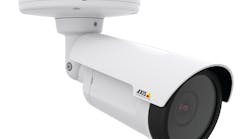Technology has always helped us see clearer - from the first crude microscopes in the late 1500s to the far reaching eye of the Hubble telescope - humans have forever been driven to find ways to expand the view of the naked eye.
We’ve seen this drive play out especially in the consumer electronics world with both the history of the television and point-and-shoot camera. These technological advances have had a major influence in video surveillance, and are a driving force behind IP video innovation. Dissatisfaction with the first grainy black-and-white analog video images helped paved the way for the shift to today’s digital acceptance. And with innovations in IP video driven by Moore’s Law, we’ve seen tremendous progress from VGA and SVGA to the HDTV and megapixel video so common today.
Then along comes 4K Ultra HDTV to help us see even clearer.
Four times 1080p HDTV resolution
Like many engineering feats, Ultra High Definition Television, or UHDTV, grew out of consumer demand for even higher image quality. With twice the horizontal and vertical resolution of 1080p HDTV, the format creates an amazing experience for cinema enthusiasts.
Like HDTV, UHDTV adheres to specific entertainment industry standards via the SMPTE and ITU-R to ensure consistent image quality.
- Resolution: at least 3840x2160 or 8.3 megapixels
- Frame rate: up to 120 fps
- Aspect ratio: 16:9
- Color fidelity: much larger color palette than HDTV
When this technology first hit the television market in 2012, the Consumer Electronics Industry (CEA) named “Ultra HD” (UHD) as the de facto industry term. However, similar to how it became common to refer to our flatscreen resolutions as 720 or 1080, the industry soon adopted the catchier “4K” moniker to represent Ultra HD since the standard offers nearly 4,000 pixels across a screen.
Whether a manufacturer calls the new resolution UHDTV, UHD or 4K, the most important factor is to confirm they are following a true industry standard. If not, we run the risk of “4K” being hijacked for marketing purposes similarly to how “HD” was used to imply the standard performance we’re used to at home for resolution, frame rate, aspect ratio and color fidelity, when it really only corresponded to pixel count.
Moving 4K from entertainment to surveillance
So how will 4K play out in the security arena? The obvious attraction is that higher resolution brings out more details, making it easier for security professionals to identify people, objects and incidents from greater distances. Users invariably want to look closer at recorded video or digitally zoom into live events to look for crucial details. Because for security, more is always better, right?
Well, not always. The distance to an object from a camera will ultimately determine how many pixels are needed for identification. There are still plenty of surveillance applications where an SVGA camera will provide more than enough detail for identification.
Then of course there’s bandwidth and storage. In the simplest terms, four times 1080p resolution means four times the bandwidth. Thus, efficient compression technologies will play an increasingly important role in the new world of 4K.
There is also the issue of 4K image sensors needing more light to activate the smaller, more numerous pixels. This reduces dynamic range and makes current 4K cameras unsuitable for certain surveillance applications where you need video despite low-light conditions. But given Moore’s Law, you can rest assured that manufacturers will conquer this limitation in the not too distant future.
Brainstorming applications for 4K
Despite the limitations that always accompany new technology innovations, there are still endless opportunities for 4K to be the smart choice for security practitioners. For instance, in outdoor applications such as multi-acre parking lots, long fence lines or coastal monitoring, 4K cameras could deliver amazing coverage with the ability to digitally zoom in from far away. With four times the resolution of 1080p HDTV, end users could leverage wider angle lenses for broader fields of view while still maintaining the appropriate number of pixels on target for detection, recognition and identification. Indoors, 4K cameras would be great surveillance tools for monitoring large, open warehouses or hangars.
Thanks to high resolution combined with up to 120 fps performance, 4K cameras can also provide excellent forensic evidence of finite details for banks and casinos where identifying the denomination of bills and chips while catching sleights of hand are paramount.
Additionally, when you combine the greater resolution of 4K cameras with the rise of the consumer TV and video monitor market, you can render quad views of native two-megapixel resolution or double the amount of one-megapixel cameras simultaneously. Prior to 4K technology, you would have been forced to downgrade the image to a lower resolution to fit on a traditional two-megapixel HDTV screen. That would have meant either cropping part of your field-of-view or decreasing the number of pixels on target, both alternatives that would have compromised the forensic value of the video.
Adapting to create a true 4K environment
In the consumer world, even if the movie or television show was filmed in 4K, we’re mostly likely viewing the video on 1080p screens at home. Even today with many consumers owning 1080p and 3D TVs, the majority of broadcasters still use 720p. So the next step for the market, which includes security, is to adapt our infrastructure to the 4K standard – hardware, video management systems, display screens and bandwidth will adapt to 4K Ultra HD so that end users can extract the full benefit of the technology. As 4K surveillance cameras begin to ship in 2014, industry experts predict that we’ll see several full-4K options by 2015.
This brings us back to an issue that I mentioned earlier: bandwidth consumption. Three factors drive up the amount of bandwidth needed – resolution, image sharpening and movement in the scene. The “four times the bandwidth” rule of thumb mentioned earlier is really meant for a static scene. In a very detailed, high traffic and/or low-light scene, 4K might consume even more bandwidth. Thus, advanced compression will be critical for 4K to thrive in real world applications.
- H.264. To use 4K Ultra HD at full resolution and frame rate, H.264 advanced video compression will require roughly 20-30 Mbps. If you compress the video stream below 10 Mbps, you will sacrifice frames, video quality or both.
- H.265. H.265, also known as High Efficiency Video Coding, is the intended successor to H.264. The more efficient compression algorithm is designed to improve video quality and double the compression ratio compared to H.264. The standard was formally published by the International Telecommunications Union in June 2013 and industry pundits expect to see consumer products with standardized H.265 by the end of the year. But the transition to relevance in the video surveillance world – with widely available surveillance cameras and all the other surrounding components like graphic cards, video displays, and video management systems – is still several years out.
Accelerating demand for IP video
While the lack of 4K content will slow consumer adoption in our homes, it will likely be a different story in the security industry. Because surveillance video is locally-generated content, 4K could actually help to accelerate the shift from analog to IP video and continue to drive down the price point for 4K components. So if you are wondering whether 4K is going to play a significant role in your future, it is a pretty safe bet to assume it will.
About the Author: Fredrik Nilsson is the general manager for Axis Communications, Inc. in North America. He has more than 15 years of experience with IP video systems and is the author of “Intelligent Network Video: Understanding Modern Video Surveillance Systems,” published by CRC Press.





